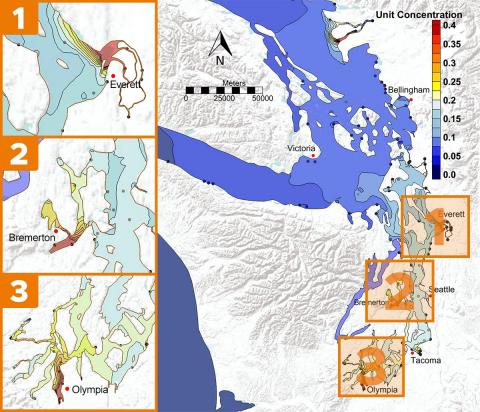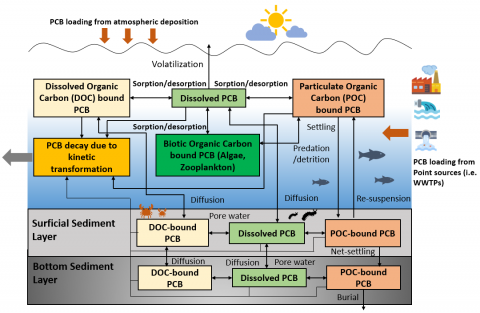Toxics Fate & Transport
Development of a Toxics Module for the Salish Sea Model Using Polychlorinated Biphenyls (PCBs)
Despite efforts to control contaminant sources and clean them up from the environment, exposure of biota to many chemicals remains high in the Salish Sea. Of particular concern are persistent, bioaccumulative hydrophobic chemicals such as polychlorinated biphenyls, (PCBs), dichlorodiphenyltrichloroethanes (DDTs), polybrominated diphenylethers (PBDEs), heavy metals, and others. Long-term toxics monitoring has shown that PCBs, in particular, are high in Puget Sound's pelagic food web, and that PCB levels have not declined in Pacific herring, a key pelagic indicator species, over the past 20 years. These patterns are likely reflected in their predators including Chinook salmon and killer whales feeding on Chinook in Puget Sound.

The Puget Sound area of the Salish Sea consists of several interconnected oceanographic basins which receive effluent from 99 wastewater sources and numerous stormwater outfalls. The circulation and exchanges between the basins are controlled by a fjord like bathymetry with shallow sills, numerous islands, and density gradients created by large freshwater inflows. This results in multiple circulation cells, with re-entrainment of surface layer outflows and high residence time for the pollutants discharged to the system. The potential long-term exposure of organisms to toxics is of concern. Understanding when, how, and where hydrophobic contaminants like PCBs enter the pelagic and benthic food webs is of utmost importance so effective management actions can be designed to reduce loading and mitigate exposure of biota.
To assist agencies responsible for the management of water quality and aquatic life, U.S. EPA has funded this 4-Year study of toxics fate and transport analysis at a Puget Sound/Salish Sea wide scale through the development of a Toxics Module for the Salish Sea Model (SSM-Toxics). The Salish Sea model (SSM) is a 3-D hydrodynamic and biogeochemical model based on finite volume community ocean models (FVCOM) for hydrodynamics and (FVCOM-ICM) biogeochemistry. A schematic of the model is shown below. It is being used by water quality management agencies for the analysis of water quality, and ecosystem response, for nutrient pollution management, sea level rise, climate change, and ocean acidification. This project adds a toxics module to SSM that would allow synthesis and re-analysis of toxics monitoring data collected throughout the Puget Sound region.

The SSM-Toxics Module development and application would be accomplished through the following approach.
- Review, Acquisition, and Preparation of Necessary Data: PCB concentration data necessary for calculating loading estimates as well as those needed for model comparison and calibration would be acquired from past research and monitoring records. These data include: PCB concentrations in freshwater, stormwater, and wastewater (point and nonpoint sources), marine sediments, and suspended particulates, in the water column.
- Development of Toxic Fate and Transport Module: A comprehensive model for fate and transport of PCBs will be incorporated into the FVCOM-ICM as the first step. All the major physio-chemical processes related to PCB fate and transport such as sorption/desorption, volatilization, decay and other chemical transformation processes will be included, adopting approaches from CE-QUAL-ICM/Toxi or EPA's WASP/Toxi models as appropriate. The model development and testing will be conducted using simplified modeling frameworks such as continuously stirred reactor tank and a rectangular channel using 1-D analytical solutions as part of QA/QC.
- Initial Model Setup and Calibration: Model setup and application over the Salish Sea wide scale will focus on matching of historical sediment and tissue data using a representative loading scenario. To facilitate model calibration, the available PCB tissue and sediment data will be converted to water column values via suitable bio concentration factors (BCFs) and bio accumulation factors (BAFs).
- Model Validation with Recently Collected Data: WDFW plans to collect PCB concentrations data in particulate organic matter (POM) and zooplankton in the marine environment to allow calibration using direct measurements of contaminant in the lowest trophic level.
Following validation, the model may be applied in sensitivity analysis mode towards developing recommendations on next steps with respect to monitoring and source control strategies. This effort led by Pacific Northwest National Laboratory is in collaboration with Washington State Department of Fish and Wildlife (WDFW) and University of Washington (UW).